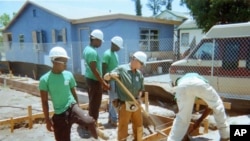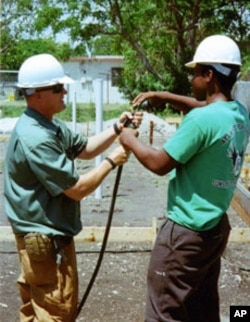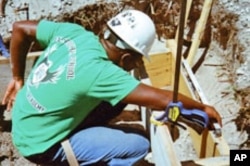On a sandy lot in the small, growing city of Delray Beach, Florida, seven teenagers are hammering and shoveling in the hot mid-day sun. The Atlantic High students are members of the school’s Eagle Nest Construction Academy, which builds houses for low-income families on land donated by the city.
The program is open to boys and girls in the 9th through 12th grades. They study drafting, design and construction, then use those skills to build the homes.
“They learn A to Z, then pick which they like better, then specialize in that," says Amanda Orndorff, who coordinates the program. "If they like the drafting side, they focus on that. If they like the actual building, they can focus on that.”
After learning the basics of safety and the fundamentals of design and building from instructor Tim Sachse, students interested in construction move with him to the work site.
“The way the program works is a stepping stone process," says Sachse, an engineer. "Construction isn’t just about hammering things together. It deals with lots of problem solving along the way and that’s probably one of those things that cannot be written in a textbook.”
About 25 students are currently working on a three-bedroom, two-bath house. Ten to 15 are on site at any one time. While on the job, they all must wear hard hats, safety glasses and heavy boots.
Senior Daniel Norzea says he and his classmates started this house in late October, building it literally from the ground up.
“It was a lot filled with grass, so we had to dig out the grass. We had to level it. Now we got through with the plumbing. We put in the footers - which is the outside area of the house - where we’ll pour the cement so we can wrap up for the summer.”
Nearby, Fladimir Celunice works on a corner of the house, where he is carefully measuring. "They all have to measure up to 12 inches. We’re pouring cement in there, and then it has to be leveled.”
Local contractors donate materials and services to the program. A local architect rendered the final plan for the house, with input from Academy students during the drafting process. In the early stages, Daniel Norzea and a classmate took the rough blueprints to city officials.
“Every aspect we’ve learned from - the engineering aspects, measurements, what works, the building codes, zoning codes," he says. "We really learned a lot.”
About 200 students have come through the Eagle Nest program since it began five years ago. This is the second house academy students have built. It’s being constructed according to green building standards. Many of the materials - like floor boards and concrete blocks - are recycled. Students will install insulated walls, energy efficient appliances and double pane windows.
Program coordinator Amanda Orndorff says environmental considerations are a new focus for a lot of the kids.
“They’re learning the concepts in the classroom and then we’re really applying them on the job site. Even as far as teaching the kids that sometimes, it’s not about just using recycled products but a product that maybe closer to your location, because it uses less fuel and creates less waste. So that's kind of a new concept for them.”
Although many of the students sign up for the program because they want to do construction after graduation from high school, some realize the building trades are not for them, and start looking for other careers.
But others, like Daniel Norzea, are here solely for the knowledge the experience offers. “I don’t want to pay a plumber or someone to come fix my house when I know how to do it myself.”
His classmate, Shligton Estime, who plans to go into structural or civil engineering, has been in the academy program for four years. He says this year has been especially exciting.
“We’re actually building it - not just reading about it or drawing it on paper. We’re building the house.”
The house is expected to be completed and ready for a family to move in the first half of next year.











